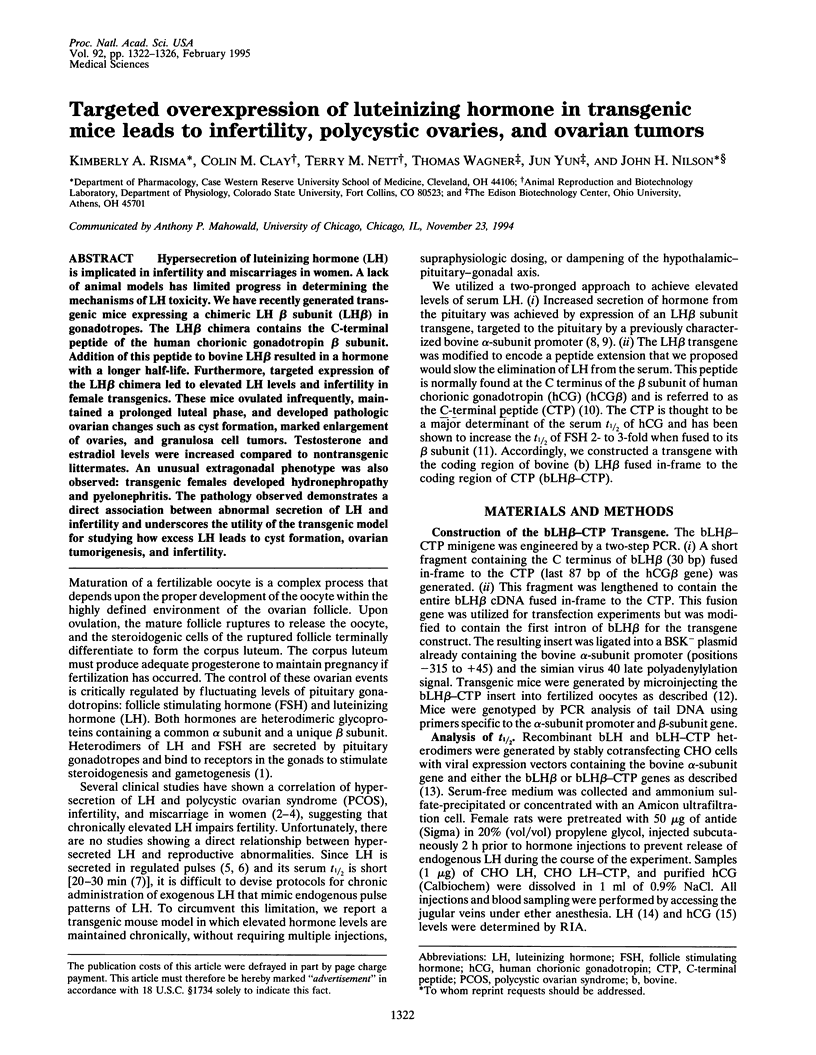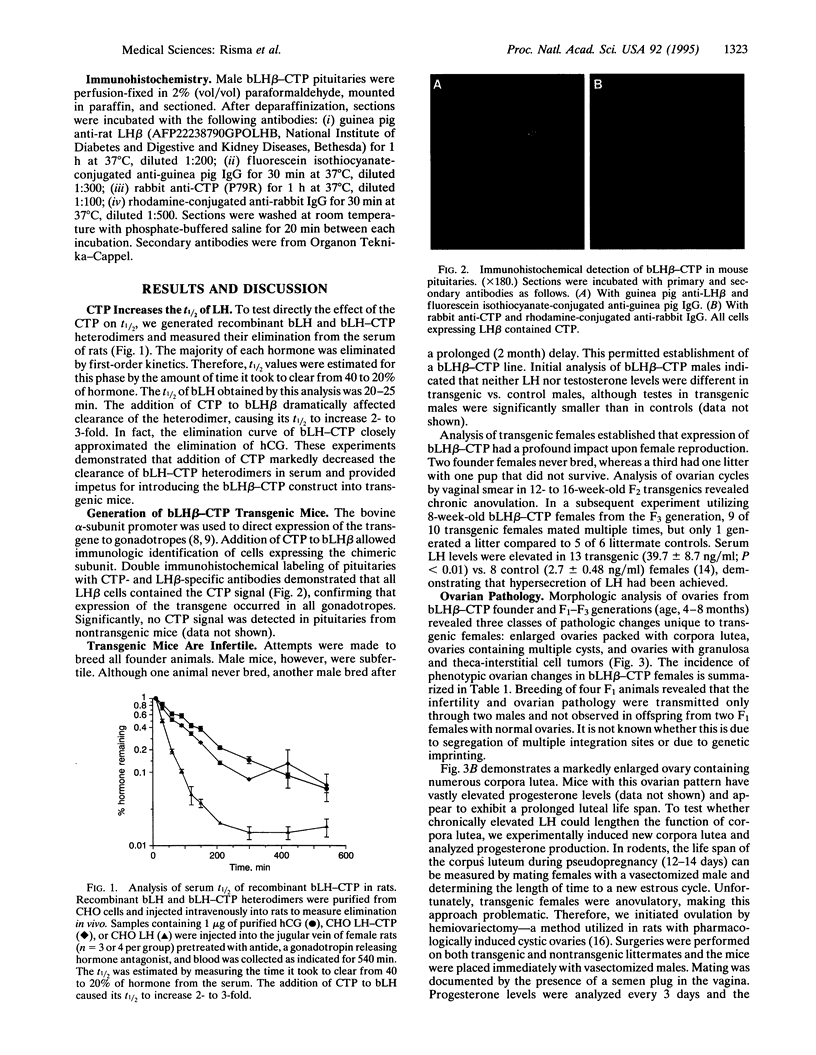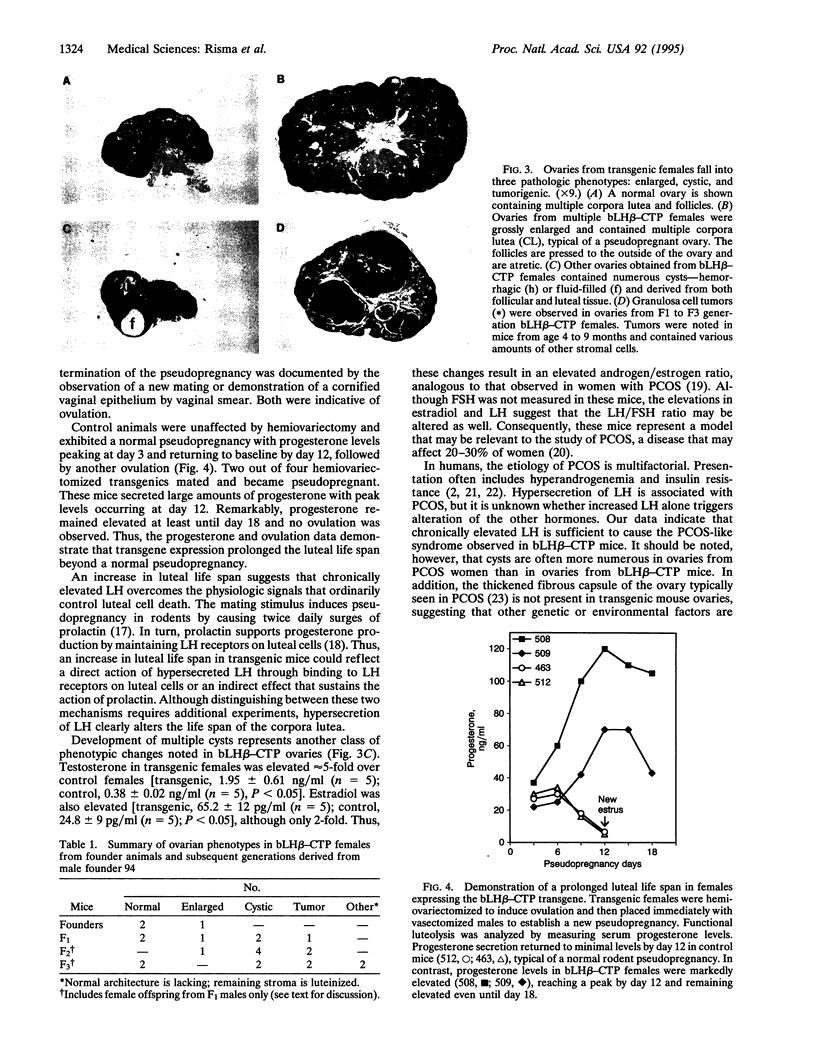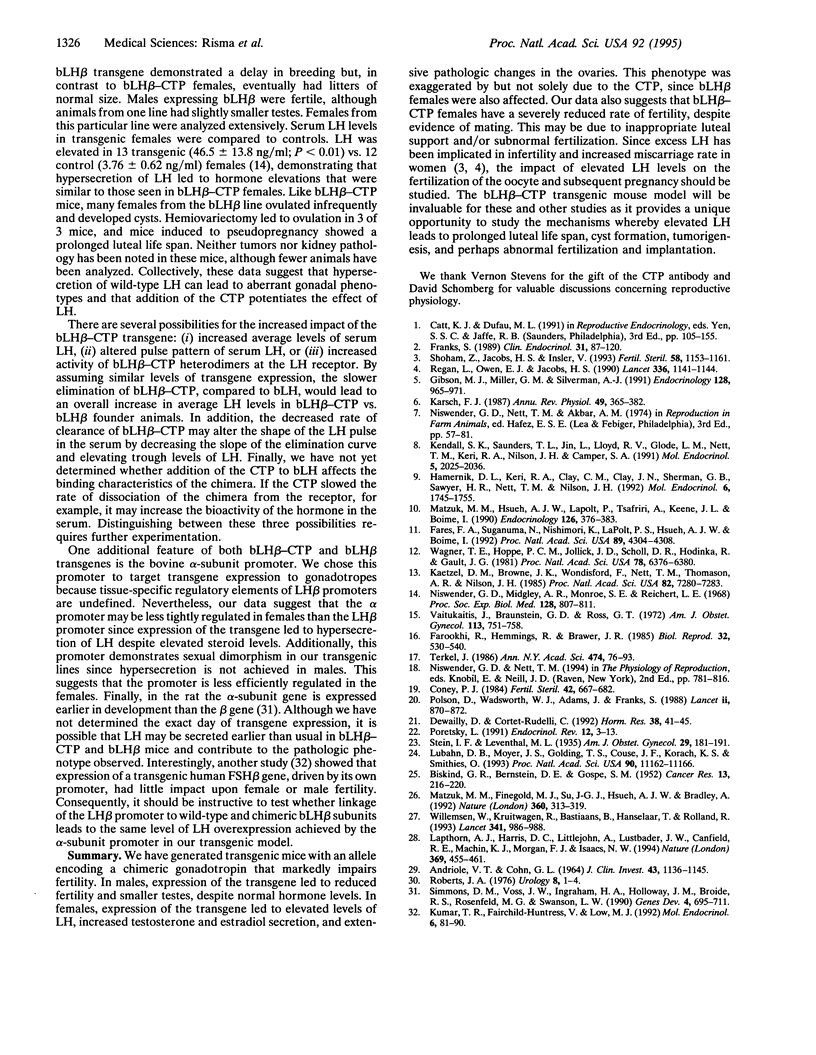Abstract
Hypersecretion of luteinizing hormone (LH) is implicated in infertility and miscarriages in women. A lack of animal models has limited progress in determining the mechanisms of LH toxicity. We have recently generated transgenic mice expressing a chimeric LH beta subunit (LH beta) in gonadotropes. The LH beta chimera contains the C-terminal peptide of the human chorionic gonadotropin beta subunit. Addition of this peptide to bovine LH beta resulted in a hormone with a longer half-life. Furthermore, targeted expression of the LH beta chimera led to elevated LH levels and infertility in female transgenics. These mice ovulated infrequently, maintained a prolonged luteal phase, and developed pathologic ovarian changes such as cyst formation, marked enlargement of ovaries, and granulosa cell tumors. Testosterone and estradiol levels were increased compared to nontransgenic littermates. An unusual extragonadal phenotype was also observed: transgenic females developed hydronephropathy and pyelonephritis. The pathology observed demonstrates a direct association between abnormal secretion of LH and infertility and underscores the utility of the transgenic model for studying how excess LH leads to cyst formation, ovarian tumorigenesis, and infertility.
Full text
PDF




Images in this article
Selected References
These references are in PubMed. This may not be the complete list of references from this article.
- ANDRIOLE V. T., COHN G. L. THE EFFECT OF DIETHYLSTILBESTROL ON THE SUSCEPTIBILITY OF RATS TO HEMATOGENOUS PYELONEPHRITIS. J Clin Invest. 1964 Jun;43:1136–1145. doi: 10.1172/JCI104998. [DOI] [PMC free article] [PubMed] [Google Scholar]
- BISKIND G. R., BERNSTEIN D. E., GOSPE S. M. The effect of exogenous gonadotrophins on the development of experimental ovarian tumors in rats. Cancer Res. 1953 Mar;13(3):216–220. [PubMed] [Google Scholar]
- Coney P. Polycystic ovarian disease: current concepts of pathophysiology and therapy. Fertil Steril. 1984 Nov;42(5):667–682. doi: 10.1016/s0015-0282(16)48189-6. [DOI] [PubMed] [Google Scholar]
- Dewailly D., Cortet-Rudelli C. Insulin resistance and polycystic ovarian syndrome. Horm Res. 1992;38(1-2):41–45. doi: 10.1159/000182482. [DOI] [PubMed] [Google Scholar]
- Fares F. A., Suganuma N., Nishimori K., LaPolt P. S., Hsueh A. J., Boime I. Design of a long-acting follitropin agonist by fusing the C-terminal sequence of the chorionic gonadotropin beta subunit to the follitropin beta subunit. Proc Natl Acad Sci U S A. 1992 May 15;89(10):4304–4308. doi: 10.1073/pnas.89.10.4304. [DOI] [PMC free article] [PubMed] [Google Scholar]
- Farookhi R., Hemmings R., Brawer J. R. Unilateral ovariectomy restores ovulatory cyclicity in rats with a polycystic ovarian condition. Biol Reprod. 1985 Apr;32(3):530–540. doi: 10.1095/biolreprod32.3.530. [DOI] [PubMed] [Google Scholar]
- Franks S. Polycystic ovary syndrome: a changing perspective. Clin Endocrinol (Oxf) 1989 Jul;31(1):87–120. doi: 10.1111/j.1365-2265.1989.tb00457.x. [DOI] [PubMed] [Google Scholar]
- Gibson M. J., Miller G. M., Silverman A. J. Pulsatile luteinizing hormone secretion in normal female mice and in hypogonadal female mice with preoptic area implants. Endocrinology. 1991 Feb;128(2):965–971. doi: 10.1210/endo-128-2-965. [DOI] [PubMed] [Google Scholar]
- Hamernik D. L., Keri R. A., Clay C. M., Clay J. N., Sherman G. B., Sawyer H. R., Jr, Nett T. M., Nilson J. H. Gonadotrope- and thyrotrope-specific expression of the human and bovine glycoprotein hormone alpha-subunit genes is regulated by distinct cis-acting elements. Mol Endocrinol. 1992 Oct;6(10):1745–1755. doi: 10.1210/mend.6.10.1280329. [DOI] [PubMed] [Google Scholar]
- Kaetzel D. M., Browne J. K., Wondisford F., Nett T. M., Thomason A. R., Nilson J. H. Expression of biologically active bovine luteinizing hormone in Chinese hamster ovary cells. Proc Natl Acad Sci U S A. 1985 Nov;82(21):7280–7283. doi: 10.1073/pnas.82.21.7280. [DOI] [PMC free article] [PubMed] [Google Scholar]
- Karsch F. J. Central actions of ovarian steroids in the feedback regulation of pulsatile secretion of luteinizing hormone. Annu Rev Physiol. 1987;49:365–382. doi: 10.1146/annurev.ph.49.030187.002053. [DOI] [PubMed] [Google Scholar]
- Kendall S. K., Saunders T. L., Jin L., Lloyd R. V., Glode L. M., Nett T. M., Keri R. A., Nilson J. H., Camper S. A. Targeted ablation of pituitary gonadotropes in transgenic mice. Mol Endocrinol. 1991 Dec;5(12):2025–2036. doi: 10.1210/mend-5-12-2025. [DOI] [PubMed] [Google Scholar]
- Kumar T. R., Fairchild-Huntress V., Low M. J. Gonadotrope-specific expression of the human follicle-stimulating hormone beta-subunit gene in pituitaries of transgenic mice. Mol Endocrinol. 1992 Jan;6(1):81–90. doi: 10.1210/mend.6.1.1738375. [DOI] [PubMed] [Google Scholar]
- Lapthorn A. J., Harris D. C., Littlejohn A., Lustbader J. W., Canfield R. E., Machin K. J., Morgan F. J., Isaacs N. W. Crystal structure of human chorionic gonadotropin. Nature. 1994 Jun 9;369(6480):455–461. doi: 10.1038/369455a0. [DOI] [PubMed] [Google Scholar]
- Lubahn D. B., Moyer J. S., Golding T. S., Couse J. F., Korach K. S., Smithies O. Alteration of reproductive function but not prenatal sexual development after insertional disruption of the mouse estrogen receptor gene. Proc Natl Acad Sci U S A. 1993 Dec 1;90(23):11162–11166. doi: 10.1073/pnas.90.23.11162. [DOI] [PMC free article] [PubMed] [Google Scholar]
- Matzuk M. M., Finegold M. J., Su J. G., Hsueh A. J., Bradley A. Alpha-inhibin is a tumour-suppressor gene with gonadal specificity in mice. Nature. 1992 Nov 26;360(6402):313–319. doi: 10.1038/360313a0. [DOI] [PubMed] [Google Scholar]
- Matzuk M. M., Hsueh A. J., Lapolt P., Tsafriri A., Keene J. L., Boime I. The biological role of the carboxyl-terminal extension of human chorionic gonadotropin [corrected] beta-subunit. Endocrinology. 1990 Jan;126(1):376–383. doi: 10.1210/endo-126-1-376. [DOI] [PubMed] [Google Scholar]
- Niswender G. D., Midgley A. R., Jr, Monroe S. E., Reichert L. E., Jr Radioimmunoassay for rat luteinizing hormone with antiovine LH serum and ovine LH-131-I. Proc Soc Exp Biol Med. 1968 Jul;128(3):807–811. doi: 10.3181/00379727-128-33129. [DOI] [PubMed] [Google Scholar]
- Polson D. W., Adams J., Wadsworth J., Franks S. Polycystic ovaries--a common finding in normal women. Lancet. 1988 Apr 16;1(8590):870–872. doi: 10.1016/s0140-6736(88)91612-1. [DOI] [PubMed] [Google Scholar]
- Poretsky L. On the paradox of insulin-induced hyperandrogenism in insulin-resistant states. Endocr Rev. 1991 Feb;12(1):3–13. doi: 10.1210/edrv-12-1-3. [DOI] [PubMed] [Google Scholar]
- Regan L., Owen E. J., Jacobs H. S. Hypersecretion of luteinising hormone, infertility, and miscarriage. Lancet. 1990 Nov 10;336(8724):1141–1144. doi: 10.1016/0140-6736(90)92765-a. [DOI] [PubMed] [Google Scholar]
- Roberts J. A. Hydronephrosis of pregnancy. Urology. 1976 Jul;8(1):1–4. doi: 10.1016/0090-4295(76)90041-8. [DOI] [PubMed] [Google Scholar]
- Shoham Z., Jacobs H. S., Insler V. Luteinizing hormone: its role, mechanism of action, and detrimental effects when hypersecreted during the follicular phase. Fertil Steril. 1993 Jun;59(6):1153–1161. doi: 10.1016/s0015-0282(16)55968-8. [DOI] [PubMed] [Google Scholar]
- Simmons D. M., Voss J. W., Ingraham H. A., Holloway J. M., Broide R. S., Rosenfeld M. G., Swanson L. W. Pituitary cell phenotypes involve cell-specific Pit-1 mRNA translation and synergistic interactions with other classes of transcription factors. Genes Dev. 1990 May;4(5):695–711. doi: 10.1101/gad.4.5.695. [DOI] [PubMed] [Google Scholar]
- Terkel J. Neuroendocrinology of coitally and noncoitally induced pseudopregnancy. Ann N Y Acad Sci. 1986;474:76–94. doi: 10.1111/j.1749-6632.1986.tb28000.x. [DOI] [PubMed] [Google Scholar]
- Vaitukaitis J. L., Braunstein G. D., Ross G. T. A radioimmunoassay which specifically measures human chorionic gonadotropin in the presence of human luteinizing hormone. Am J Obstet Gynecol. 1972 Jul 15;113(6):751–758. doi: 10.1016/0002-9378(72)90553-4. [DOI] [PubMed] [Google Scholar]
- Wagner T. E., Hoppe P. C., Jollick J. D., Scholl D. R., Hodinka R. L., Gault J. B. Microinjection of a rabbit beta-globin gene into zygotes and its subsequent expression in adult mice and their offspring. Proc Natl Acad Sci U S A. 1981 Oct;78(10):6376–6380. doi: 10.1073/pnas.78.10.6376. [DOI] [PMC free article] [PubMed] [Google Scholar]
- Willemsen W., Kruitwagen R., Bastiaans B., Hanselaar T., Rolland R. Ovarian stimulation and granulosa-cell tumour. Lancet. 1993 Apr 17;341(8851):986–988. doi: 10.1016/0140-6736(93)91071-s. [DOI] [PubMed] [Google Scholar]





